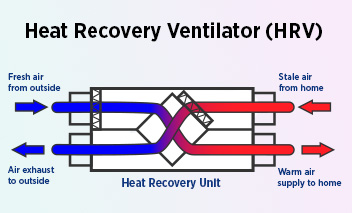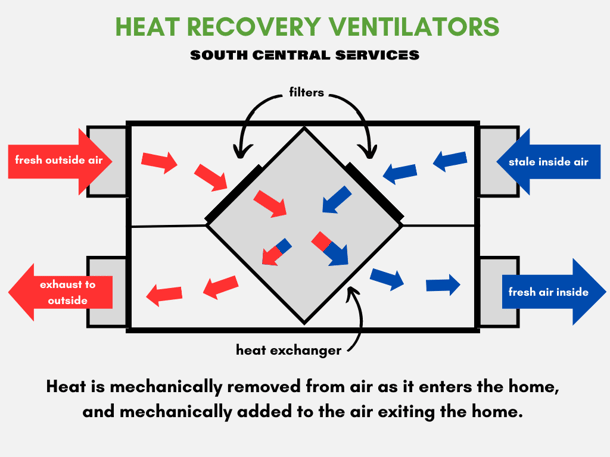The All-Inclusive Guide to the Uses of Heat Recovery Ventilation in Modern Buildings
Heat Recovery Ventilation (HRV) systems represent a considerable advancement in constructing innovation (HRV Heat Recovery Ventilation). They offer a technique for trading stagnant indoor air with fresh exterior air while reducing power loss. This method not just enhances interior air top quality however also contributes to energy effectiveness in both residential and industrial buildings. Recognizing the numerous applications and advantages of HRV can reveal its crucial role in modern design and sustainability efforts. The ramifications of this modern technology deserve checking out better
Comprehending Heat Recovery Ventilation Solutions

Numerous modern structures prioritize power efficiency, recognizing heat healing ventilation (HRV) systems is crucial for maximizing interior air quality and decreasing power intake. HRV systems work by transferring heat from stale interior air to incoming fresh air, efficiently keeping comfy indoor temperatures while decreasing energy loss. These systems contain a warm exchanger, followers, and ductwork that assist in the flow of air. Throughout wintertime, HRV systems catch and reuse warmth from the outbound air, while in summer season, they can help cool down inbound air. By continually exchanging air, HRV systems also decrease humidity and the focus of indoor contaminants. Proper setup and upkeep of HRV systems are crucial for their performance and efficiency in boosting overall structure performance and comfort.
Benefits of Heat Recovery Ventilation
Heat recovery ventilation systems offer numerous advantages that improve both energy efficiency and indoor air quality in modern-day buildings. By catching and recycling energy from exhaust air, these systems greatly reduce heating & cooling expenses, leading to lower power consumption. They preserve a steady circulation of fresh outdoor air, lessening the risk of interior air pollutants and irritants. This continual exchange helps control humidity degrees, preventing mold and mildew development and guaranteeing a much healthier living setting. Furthermore, HRV systems add to sustainability objectives by reducing overall carbon footprints. Their ability to enhance air flow without sacrificing thermal comfort makes them a beneficial enhancement to contemporary structure design, advertising both economic and environmental advantages.
Applications of HRV in Residential Buildings
As home owners progressively prioritize energy performance and interior air high quality, the applications of warmth recovery air flow (HRV) systems in property buildings have actually become much more common. HRV systems are particularly beneficial in snugly sealed homes, where maintaining fresh air circulation is essential for stopping dampness accumulation and indoor contaminants. They effectively transfer warmth from outbound stagnant air to inbound Our site fresh air, decreasing energy costs associated with home heating and air conditioning. Furthermore, HRVs can improve convenience degrees by controling moisture and temperature level. They are additionally adaptable for different household layouts, including single-family homes and multi-unit buildings. Generally, incorporating HRV systems sustains lasting living practices while guaranteeing a much healthier interior environment for residents.
HRV in Business and Industrial Settings
In industrial and commercial setups, the execution of warm recuperation ventilation (HRV) systems has ended up being significantly essential for optimizing energy effectiveness and preserving air high quality. These systems properly move heat from exhaust air to inbound fresh air, try this decreasing the need for additional heating or cooling. This not only lowers power prices yet also adds to sustainability initiatives. Industries such as manufacturing, warehousing, and office complex profit greatly from HRV systems, as they help regulate temperature level and moisture levels, guaranteeing a comfortable and effective environment. Additionally, HRV systems help in removing contaminants and excess wetness, boosting indoor air high quality. As guidelines around air quality come to be stricter, the fostering of HRV technology is likely to grow, making it a vital component of modern-day commercial and industrial framework.
Future Fads in Heat Recovery Ventilation Modern Technology

Often Asked Questions
Just How Does Heat Recovery Ventilation Impact Indoor Air High Quality?
Heat recovery ventilation substantially enhances indoor air quality by constantly exchanging stagnant interior air with fresh exterior air while recuperating power. This process decreases toxins, preserves optimal moisture levels, and guarantees a much healthier atmosphere for residents.
Can HRV Systems Be Mounted in Existing Buildings?
HRV systems can without a doubt be mounted in existing structures. Retrofitting may require modifications to ductwork and air flow formats, however it considerably boosts power effectiveness and indoor air quality, making it a feasible option for older frameworks.
What Upkeep Is Needed for HRV Systems?

Exist Certain Climates Where HRV Is Extra Efficient?
Heat recovery ventilation systems are particularly reliable in climates with considerable temperature level differences between seasons. These systems maximize energy effectiveness by recovering warm from exhaust air, making them perfect for both cold and moderately cozy atmospheres.
Just How Do HRV Solutions Affect Power Costs?
